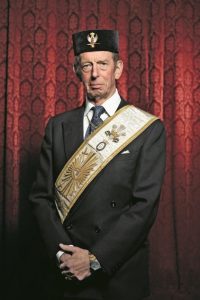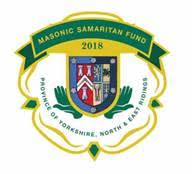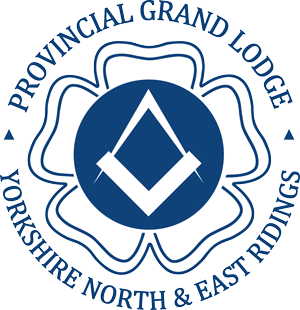What is Freemasonry?

We are a fraternal organisation which is warranted and properly constituted under the United Grand Lodge of England (UGLE). Freemasons raise substantial amounts of money for charity and other good causes and are collectively second only to the National Lottery in terms of charitable donations, and are one of the oldest social and charitable organisations in the world.
Our roots lie in the traditions of the medieval stonemasons, where elements of Freemasonry find their origins. Historically, stonemasons often travelled around to find work in different locations. To demonstrate their level of qualification, they would use grips, words and signs in order to distinguish themselves from unqualified builders.
This has been carried on in to Freemasonry, which uses building analogies to teach members how to lead productive lives that benefit the communities that they live in. Working stonemasons wore aprons and gloves to protect themselves while working on shaping rough pieces of stone, but in today’s society Freemasons meet to build friendships and communities rather than cathedrals and castles.
If you are interested in becoming a freemason, or are merely curious to know more, then we suggest that you click on this link to the UGLE web site. More specific enquiries relating to membership of a particular Lodge should be addressed to the Lodge Secretary, whose contact details may be found on the individual Lodge sections of this web site.
At some point in the year, we usually hold an open event, where we invite members of the public, press, potential members and their ladies and any other interested parties, to look around the Lodge, listen to a presentation and join us in a meal afterwards. If you would like to come along to an open evening, please contact the Joint Lodge Board Secretary, who will be delighted to supply you with details of our next event.
Click here to view a You tube video about Freemasonry

Every Mason is a member of at least one Craft Lodge. A man becomes a Freemason by being initiated into one of these Craft Lodges, usually the one which meets nearest to where he lives or works, although there may be reasons why he joins one further away.
There are five private Lodges that share their home at The Masonic Lodge, St. John’s Avenue Bridlington which meet on separate days and times to hopefully suit everyone.
Holy Royal Arch Chapters
 So what is Chapter?
So what is Chapter?
Chapter is a continuation of Craft Freemasonry. Its members, called Companions meet in Chapters ruled over by three Principals, who rule conjointly, and the Grand Chapter is ruled over by three Grand Principals, with a Pro First Grand Principal when the First Grand Principal is a Royal Prince, as at present.
Chapters in England and Wales are grouped as a Metropolitan area or in Provinces (based on the old Counties) and Chapters overseas are grouped in Districts. Metropolitan, Provincial and District Grand Chapters are ruled over by a Grand Superintendent who is appointed by the First Grand Principal as his personal representative for that particular area.
Bridlington Masonic Hall is home to three Royal Arch Chapters.
Knights Templar
 The Provincial Priory of North and East Yorkshire
The Provincial Priory of North and East Yorkshire
The full title of the order is “The United Religious, Military and Masonic Order of the Temple and St John of Jerusalem, Palestine, Rhodes and Malta in England and Wales and its Provinces Overseas”. It is a masonic military order, but there is no documented direct link between the present day knights and the original Knights Templar who’s initial purpose was to protect pilgrims visiting the Holy Sepulchre in Jerusalem.
On 15th July 1099 the city walls of Jerusalem were breached and the city captured by the Crusader army of the 1st crusade but it was not until 1118 that nine knights under the leadership of Hughes de Payen, approached the patriarch of Jerusalem (King Baldwin II); having decided to dedicate their lives to the service of the Holy land. The patriarch subsequently assigned them a portion of the al-Aqsa Mosque on the Temple Mount (said to have been built on the original Temple of Solomon). This group of knights subsequently took their name from this and were known as: Pauperes commiltones Christi Templi Salomonis (the Poor Fellow-Soldiers of Christ and the Temple of Solomon). Thus becoming known as the Knights of the Temple, and later, Knights Templar.
The earliest references of the Knights Templar order activity in the British Isles can be found in Ireland. The earliest references in England were minuted at Portsmouth in 1777 and were worked under the authority of Royal Arch Chapters as appendant degrees. in 1791 a Grand Conclave was formed comprising seven apendant Encampments with Thomas Dunckerley as Grand Master.The oldest Knight Templar unit in Yorkshire is based in Hull (although originally in York) and it can demonstrate a continuous existence from 1778. (Although it now operates under a warrant granted in 1791 following the establishment of the Grand Conclave).This is the Ancient York Conclave of Redemption ’B’ Time Immemorial.
At this time Freemasonry had a Christian base and was worked in five degrees under a single Lodge warrant. The fist three degrees were what is to day known as Craft masonry, the fourth Chapter and the fifth Knights Templar. In due time the Craft and Chapter lost their Christian base but the historical connections between all the degrees can still be found in parts of the present day K.T. ceremonies.In the Province of North and East Yorkshire, we have 13 Preceptories and several hundred members, called Sir Knights and Brother Knights who operate under the direction of the Provincial Prior, Right Eminent Knight Paul Martyn Darley BEM. A newly Installed Knight will go through an extremely interesting ceremony; taking him through a pilgrimage and then knighthood as a Templar. There is also a Mediterranean Pass and Malta degree; which is usually conferred at a meeting once in every year.
Graham Miles / 16/10/2015
Other Orders
Bridlington Masonic Hall is home to two additional Chapters – Rose Croix and Mark.
 Known outside England, Wales, Scotland and Ireland as the Scottish Rite, this order takes as its founding documents the Grand Constitutions of 1762 and 1786, the latter written by a group of eminent Freemasons under the titular direction of Frederick the Great.
Known outside England, Wales, Scotland and Ireland as the Scottish Rite, this order takes as its founding documents the Grand Constitutions of 1762 and 1786, the latter written by a group of eminent Freemasons under the titular direction of Frederick the Great.
The first Supreme Council (as national governing bodies of the Rite are known) was founded in South Carolina in 1801, with responsibility for an area now known as the Southern Jurisdiction of the United States. A Supreme Council for the Northern Masonic Jurisdiction of the United States was created in 1813, and it is from that body that England and Wales received its warrant of constitution in 1845.
WHAT’S IN A NAME?
Documents issued with this warrant instructed that membership be restricted to those of the Trinitarian Christian faith, but today (apart from the British Isles and three other countries) all Supreme Councils around the world use the Craft requirement of a belief in a Supreme Being.
The Rite consists of 33 degrees, of which (in most jurisdictions) the three degrees of Craft Freemasonry are accepted in lieu of the first three degrees of the Rite. Of the remaining 30, different jurisdictions work different degrees, but in England and Wales just five are worked: the 18°, 30°, 31°, 32° and 33°. The only one worked in chapters is the 18°, known by the grand title of Sovereign Prince of the Rose Croix of Heredom. It is from this that the Order gets its nickname in England and Wales: Rose Croix.
EDUCATING THE MEMBERSHIP
The 18° is a profound and complex ritual, and one much loved by the members of the Order. The other four degrees are worked only at the Order’s headquarters in London. The ‘intermediate degrees’ from the 4° to the 17° are not worked in this country; however, a group of ritualists, the King Edward VII Chapter of Improvement, demonstrate one or two of them each year around the country for the education of the membership.
The 30° is roughly equivalent to Past Master and is awarded to those who have successfully completed a year in the Chair of their chapter. Degrees beyond the 30° are strictly limited, being granted by the Supreme Council for outstanding service to the Order. These promotions are not mere investitures at which a collar or sash is awarded, but a full ritual carried out by the Supreme Council itself.
Promotion to the 33°, the highest of the Rite, is restricted to Members of the Supreme Council, Inspectors General (roughly equivalent to Provincial Grand Masters) and a few other very senior members of the Order. Past members of the 33° have included Their Majesties King Edward VII, Edward VIII and George VI, and more recently Their Royal Highnesses The Duke of Kent and Prince Michael of Kent. The Duke of Kent is Grand Patron of the Order, an office formerly held by his father, the first Duke.
The Supreme Council collectively acts as Grand Master of the Order. No Council Member can instigate change without the unanimous consent of the others, which removes opportunities for confrontation. This also helps to maintain a happy and productive environment while the Council strives to work in the best interests of the Order and its members.
The Order has a flat structure: there are no Provincial Grand Lodges. Rather, each District is overseen by an Inspector General. There is therefore no significant gap in communications between individual members and the Supreme Council, a fact much prized both by the membership and the Council itself. The Supreme Council for England and Wales is ‘in amity’ with more than 40 other countries around the world, meaning members within this jurisdiction may visit chapters in those countries, thus promoting masonic harmony across the Scottish Rite, the largest international masonic community after the Craft.
For further information, contact the Supreme Council on info@sc33.org.uk
FACTFILE
With their own terminology, structures and practices, each masonic Order is different from the next. Here we break down the origins, requirements and beliefs of Rose Croix.
Why is it called Rose Croix?
The nickname Rose Croix derives from the 18° of the Order, the Rose Croix of Heredom.
Where is it based?
The Order is based at 10 Duke Street, St James’s, London, traditionally known as the Grand East. It moved there in 1910 from its old headquarters, which had perhaps the most masonic address in London: 33 Golden Square!
What is the relationship between the Craft and Rose Croix?
Although neither formally recognises the other, in practice the relationship is an extremely close one. The Grand Master, Pro Grand Master and Deputy Grand Master are all members of the 33° and the Grand Master is the Grand Patron of the Order. Similarly, all nine Members of the Supreme Council are Grand Officers of UGLE.
Who runs it?
The Order is headed by a Supreme Council of nine eminent members. The current Sovereign Grand Commander (Chairman of the Council) is Alan Englefield, formerly Provincial Grand Master for Oxfordshire and the first Grand Chancellor of UGLE.
How many members are there?
There are around 27,000 members, with around 24,000 in England and Wales and 3,000 in its Districts overseas. Worldwide there are many, many more, with more than a quarter of a million in the US alone.
Is the country divided into Provinces in the same way as the Craft?
Yes, although in this Order they are called Districts. Each is headed by an Inspector General.
What is the supreme council’s emblem?
It is a double-headed eagle surmounted by a crown and holding a sword between its claws. A triangle on top of the crown displays the number 33. Underneath reads ‘Deus Meumque Jus’, which translates as ‘God and my right’.
Is Rose Croix an ‘invitation only’ Order?
Absolutely not! Membership is open to all those who have been a Master Mason for at least one year and are prepared to sign a declaration that they profess the Trinitarian Christian faith.
How many people hold the 33°?
There are around 150 members of the 33° in England and Wales, of whom the large majority are current or past Inspectors General.
The first record of Mark Masonry in England is in 1769, when Thomas Dunckerley, as Provincial Grand Superintendent, conferred the degrees of Mark Mason and Mark Master at a Royal Arch Chapter in Portsmouth.
Following the Union of the Antients and Moderns Grand Lodges and the formation of the United Grand Lodge of England in 1813, the articles of union stated that there would be three Craft degrees only, including the Royal Arch, excluding the Mark degree.
 For this reason, while in the rest of the world Mark Masonry became attached to Royal Arch chapters, in England it was actually proscribed from the Union until the 1850s. It was a group of Scottish masons who procured an illegal warrant from Bon Accord Chapter in Aberdeen to set up a Mark lodge in London. An attempt to add Mark Masonry to the approved craft workings was defeated in 1856, and a Grand Lodge of Mark Master Masons was created in response.
For this reason, while in the rest of the world Mark Masonry became attached to Royal Arch chapters, in England it was actually proscribed from the Union until the 1850s. It was a group of Scottish masons who procured an illegal warrant from Bon Accord Chapter in Aberdeen to set up a Mark lodge in London. An attempt to add Mark Masonry to the approved craft workings was defeated in 1856, and a Grand Lodge of Mark Master Masons was created in response.
As Freemasonry spread around the globe in the 18th and 19th centuries, Mark Masonry expanded with it, with six daughter Grand Lodges and the degree being worked under alternative administrative structures elsewhere. In England, the current Mark Grand Master is Prince Michael of Kent.

 In the province of Yorkshire, North and East
In the province of Yorkshire, North and East




